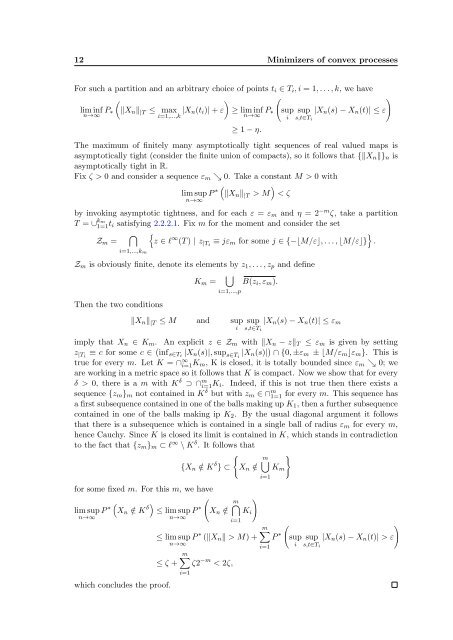Subsampling estimates of the Lasso distribution.
Subsampling estimates of the Lasso distribution.
Subsampling estimates of the Lasso distribution.
You also want an ePaper? Increase the reach of your titles
YUMPU automatically turns print PDFs into web optimized ePapers that Google loves.
12 Minimizers <strong>of</strong> convex processes<br />
For such a partition and an arbitrary choice <strong>of</strong> points t i ∈ T i , i = 1, . . . , k, we have<br />
(<br />
)<br />
(<br />
)<br />
lim inf P ∗ ‖X n ‖<br />
n→∞ |T ≤ max |X n(t i )| + ε ≥ lim inf P ∗ sup sup |X n (s) − X n (t)| ≤ ε<br />
i=1,...,k n→∞ i s,t∈T i<br />
≥ 1 − η.<br />
The maximum <strong>of</strong> finitely many asymptotically tight sequences <strong>of</strong> real valued maps is<br />
asymptotically tight (consider <strong>the</strong> finite union <strong>of</strong> compacts), so it follows that {‖X n ‖} n is<br />
asymptotically tight in R.<br />
Fix ζ > 0 and consider a sequence ε m ↘ 0. Take a constant M > 0 with<br />
(<br />
lim sup P ∗ ‖X n ‖ |T > M<br />
n→∞<br />
)<br />
< ζ<br />
by invoking asymptotic tightness, and for each ε = ε m and η = 2 −m ζ, take a partition<br />
T = ∪ km<br />
1=1 t i satisfying 2.2.2.1. Fix m for <strong>the</strong> moment and consider <strong>the</strong> set<br />
Z m =<br />
⋂ {<br />
}<br />
z ∈ l ∞ (T ) | z |Ti ≡ jε m for some j ∈ {−⌊M/ε⌋, . . . , ⌊M/ε⌋} .<br />
i=1,...,k m<br />
Z m is obviously finite, denote its elements by z 1 , . . . , z p and define<br />
K m =<br />
⋃<br />
B(z i , ε m ).<br />
Then <strong>the</strong> two conditions<br />
i=1,...,p<br />
‖X n ‖ |T ≤ M and sup<br />
i<br />
sup |X n (s) − X n (t)| ≤ ε m<br />
s,t∈T i<br />
imply that X n ∈ K m . An explicit z ∈ Z m with ‖X n − z‖ T ≤ ε m is given by setting<br />
z |Ti ≡ c for some c ∈ ( inf s∈Ti |X n (s)|, sup s∈Ti |X n (s)| ) ∩ {0, ±ε m ± ⌊M/ε m ⌋ε m }. This is<br />
true for every m. Let K = ∩ ∞ i=1 K m, K is closed, it is totally bounded since ε m ↘ 0; we<br />
are working in a metric space so it follows that K is compact. Now we show that for every<br />
δ > 0, <strong>the</strong>re is a m with K δ ⊃ ∩ m i=1 K i. Indeed, if this is not true <strong>the</strong>n <strong>the</strong>re exists a<br />
sequence {z m } m not contained in K δ but with z m ∈ ∩ m 1=1 for every m. This sequence has<br />
a first subsequence contained in one <strong>of</strong> <strong>the</strong> balls making up K 1 , <strong>the</strong>n a fur<strong>the</strong>r subsequence<br />
contained in one <strong>of</strong> <strong>the</strong> balls making ip K 2 . By <strong>the</strong> usual diagonal argument it follows<br />
that <strong>the</strong>re is a subsequence which is contained in a single ball <strong>of</strong> radius ε m for every m,<br />
hence Cauchy. Since K is closed its limit is contained in K, which stands in contradiction<br />
to <strong>the</strong> fact that {z m } m ⊂ l ∞ \ K δ . It follows that<br />
{<br />
}<br />
m⋃<br />
{X n /∈ K δ } ⊂ X n /∈ K m<br />
for some fixed m. For this m, we have<br />
lim sup<br />
n→∞<br />
( P ∗ X n /∈ K δ) ≤ lim sup P<br />
(X ∗ n /∈<br />
n→∞<br />
which concludes <strong>the</strong> pro<strong>of</strong>.<br />
≤ lim sup P ∗ (‖X n ‖ > M) +<br />
n→∞<br />
m∑<br />
≤ ζ + ζ2 −m < 2ζ,<br />
i=1<br />
i=1<br />
)<br />
m⋂<br />
K i<br />
i=1<br />
m∑<br />
i=1<br />
P ∗ (sup<br />
i<br />
sup |X n (s) − X n (t)| > ε<br />
s,t∈T i<br />
)
















